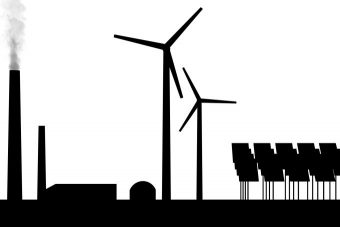
Renewable energy sources are now providing more electricity than nuclear power for the first time ever in the United States, according to figures issued by the US Energy Information Administration and highlighted by Ken Bossong’s Sun Day Campaign.
The US Energy Information Administration (EIA) published its most recent “Electric Power Monthly” report last week, with data for April of this year. While natural gas continues to lead, followed by coal, renewable energy sources — a combined total of biomass, geothermal, hydropower, solar, and wind — beat out nuclear energy. The figures have shown it swinging in renewables’ favor, and it grew tight over the first third of this year — renewable energy providing 20.20% of US net electrical generation, while nuclear provided 20.75%. However, for two months straight now, renewable energy sources overtook nuclear — 21.60% for renewables and 20.34% for nuclear in March, and 22.98% for renewables and 19.19% for nuclear in April.
Renewable energy output has been growing steadily, and between the first third of 2016 and 2017, renewables increased their share by 12.1%, whereas nuclear output dropped by 2.9% (so far, we’re seeing coal as the biggest loser in terms of overall share).
It was only a fortnight ago that we learned that, for the first time ever, US wind and solar electricity generation exceeded 10% of the monthly total (in March) — not bad, considering that wind and solar accounted for 7% of 2016’s total electricity generated (although, it’s also possible the EIA undersold the real numbers).
Nuclear energy capacity has been dropping off over the past four years, a trend which is expected to continue moving forward as well. Between 2013 and 2016, six separate nuclear reactors permanently ceased production (Crystal River, Kewaunee, San Onofre-2, San Onofre-3, Vermont Yankee, Fort Calhoun) amounting to 4,862 MW of generation capacity gone from the system. Meanwhile, only one new reactor came online during 2016, adding 1,150 MW, and six more reactors are scheduled to close over the next four years.
Meanwhile, unsurprisingly, renewable energy sources are all experiencing strong growth in the United States. Year-over-year growth between the first third of 2016 to 2017, solar has grown by 37.9%, wind by 14.2%, hydropower by 9.5%, and geothermal by 5.3%.
“In light of their growth rates in recent years, it was inevitable that renewable sources would eventually overtake nuclear power,” said Ken Bossong, Executive Director of the SUN DAY Campaign. “The only real surprise is how soon that has happened — years before most analysts ever expected.”
“Renewable energy is now surpassing nuclear power, a major milestone in the transformation of the U.S. energy sector,” said Tim Judson, Executive Director of the Nuclear Information and Resource Service. “This gulf will only widen over the next several years, with continued strong growth of renewables and the planned retirement of at least 7% of nuclear capacity by 2025. The possible completion of four new reactors will not be enough to reverse this trend, with total nuclear capacity falling by 2,806 MW (3%) through 2025.”
Source: cleantechnica.com



